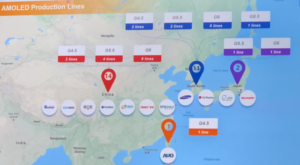In his thought leadership keynote, (OK, they are supposed to be thought leadership talks) Visionox CEO Dr. Deqiang Zhang took us down the path of the OLED golden era that will introduce display ubiquity to the world. We can’t really blame his views for being a bit one-sided as Zhang spent the last 22 years in OLED development, and holds 30 patents. He is an early (1990’s) pioneer, and in at the founding of the Visionox group back in his days at Tsinghua University. We’re talking ground floor technology development era in China, and the days of Google, MS, and Sun Microsystems first business park addresses, just outside the university gates.
Fast forward 22 years, and 6000 employees later and Visionox has grown into an OLED powerhouse with 3400 (plus) patents and 4 international standards (in China?) The group also claims development of a gen 5.5, and two gen 6 AMOLED mass production lines (Kunshan, Gu’an and Bazhou, China respectively). The Bazhou is for flexible AMOLED production.
Globally OLED production is centralized in Asia and according to Visionox China (not Korea) is the leader in its production. See the world map below highlighting the OLED lines worldwide.
Map of the world of OLED production according to Visionox keynote SID 2018, Source: Company, photo, Sechrist
Certainly on the mind of any display fab operator is cost and that gets down to the materials required to make the display. On that front Zang shared two interesting slides showing materials suppliers and equipment vendors to the industry.
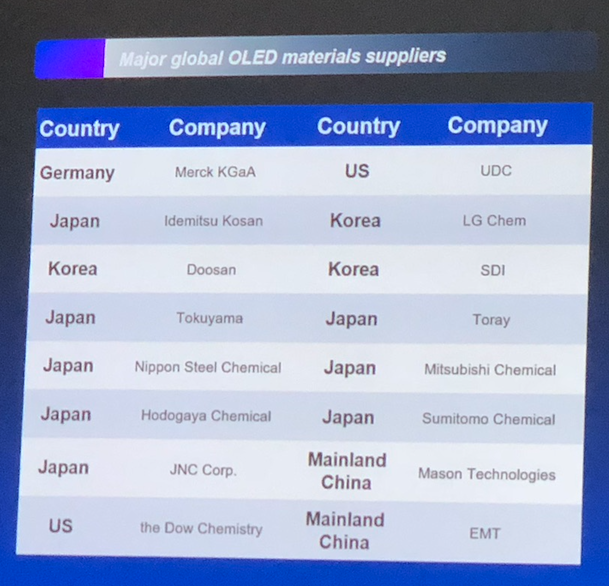
 OLED world wide equipment vendors, source Visionox,, Sechrist
OLED world wide equipment vendors, source Visionox,, Sechrist
On the technology side, the Visionox keynote was punctuated with the March 2018 announcement of an OLED display breakthrough, the world’s first mass produced flexible and foldable 7.2 inch AMOLED display that can withstand 200K folds. See below.
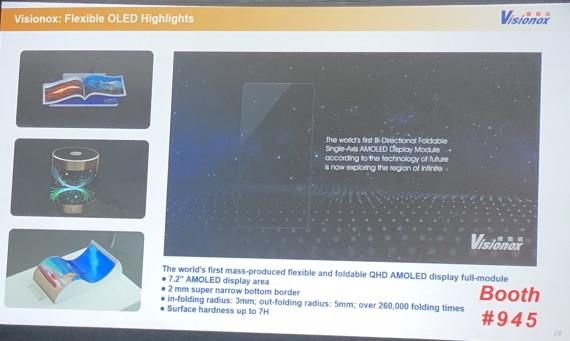
But to Zhang and his Visionox team, it’s OLED cost competitiveness that ultimately will open the golden era of OLED displays. He showed an image of visionary Elon Musk in one of the last keynote slides under the moniker of cost competitiveness, stating: The OLED panel accounts for roughly ⅓ of the total cost of the iPhone X, Zhang then muses that if the cost were reduced by ⅓ to ½ OLED will find a wide range of applications.
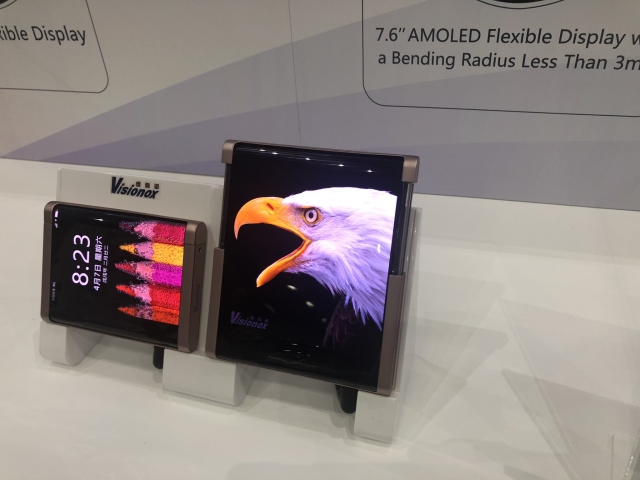 Visionox flexible display shown at SID Display Week 2018 show floor, Source: SechristZhang’s solution is technology collaboration with the industry including upstream that includes glass makers, OLED materials, backlight (? not really needed for OLEDs); “midstream collaboration” with panel makers, chip, sensor, battery, camera, and component makers; plus downstream collaboration with device and application makers.
Visionox flexible display shown at SID Display Week 2018 show floor, Source: SechristZhang’s solution is technology collaboration with the industry including upstream that includes glass makers, OLED materials, backlight (? not really needed for OLEDs); “midstream collaboration” with panel makers, chip, sensor, battery, camera, and component makers; plus downstream collaboration with device and application makers.
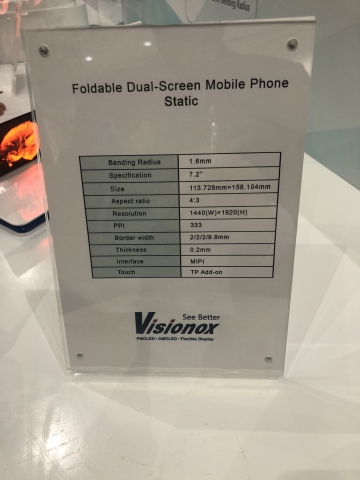 Perhaps the most remarkable thing about the Visionox keynote at the SID Display Week was the coming of age of the Chinese technology prowess in the OLED space. The company, and indeed the country of China has put OLED at the forefront of its display research and development efforts, with global consequences that are sure to impact us all.
Perhaps the most remarkable thing about the Visionox keynote at the SID Display Week was the coming of age of the Chinese technology prowess in the OLED space. The company, and indeed the country of China has put OLED at the forefront of its display research and development efforts, with global consequences that are sure to impact us all.
Here is a little background on the speaker and company:
With one of China’s leading OLED development pioneers at it’s head, Dr. Deqiang Zhang introduced his company Visionox and its vision for the golden age of OLED as the key technology to lead the world to display ubiquity. His company like many high tech companies in China was incubated from roots at a research university. The OLED Technology Group of Tsinghua University, was established in 1996 and ran through 2003 when Visionox Bejing was established to run its first OLED pilot line. –Steven Sechrist
Analyst Comment
A mis-communication meant that we covered this keynote twice, so I’ve included both as they are not long. (BR)

